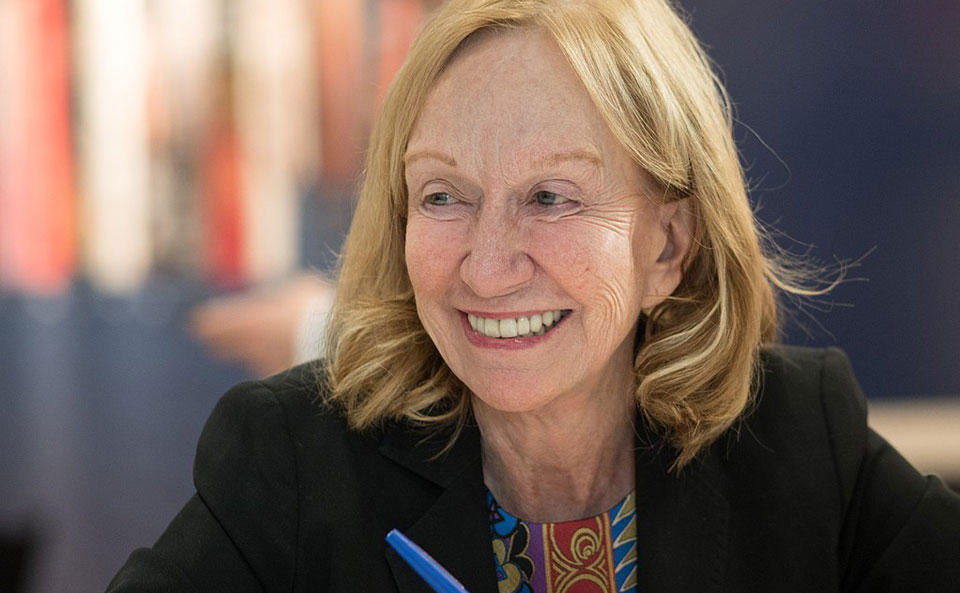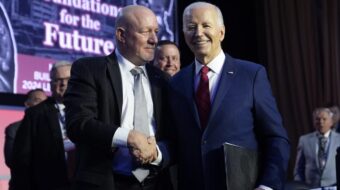
LOS ANGELES—Presidential leadership success is a matter of timing, empathy for what the U.S. people are going through, and setting clear goals early in your term—and pushing them hard—before partisan politics rises and influence wanes.
And telling people the truth, in terms everyone can understand, is a key, too.

So says noted historian Doris Kearns Goodwin, prize-winning author of books about five presidents ranging from Abraham Lincoln in Team of Rivals to Franklin and Eleanor Roosevelt in No Ordinary Time to volumes about Lyndon Johnson.
Democratic President Joe Biden appears to have learned those lessons, she said in an hour-and-a-half Q&A via sponsored by the Los Angeles-based Jews United for Democracy and Justice. Whether he can achieve his agenda is another matter.
If he can, it’ll be important not just to Biden, but to nationwide confidence, Goodwin adds. That’s a lesson groups of historians have already discussed with Biden, too.
“If FDR was here, he’d say ‘You have to restore trust—trust in government and trust in leadership.’ It had been undone in the 1920s and 30s. It’s been undone in the last four years,” Goodwin said, a reference, not by name, to former GOP Oval Office occupant Donald Trump.
The coronavirus pandemic and the ensuing depression caused by business closures and lockdowns to battle the community spread of the plague took center stage in the interview. The moderator told viewers to “take notes,” since the program would not air on social media.
And it’s the pandemic and Biden’s comprehensive plans to roll out vaccines and inoculate the entire country and end the depression, too, that led Goodwin to compare these months under Biden to FDR’s first 100 days of the New Deal, favorably.
“The Depression was at its worst moment” when FDR took over on March 4, 1933. “One out of four people were out of work, the banking system had collapsed and you couldn’t even get your money out” because hundreds of banks had closed or failed. People were losing homes and farms to foreclosures.
“And Herbert Hoover had not mobilized the federal government” to fight the disasters. After Roosevelt took over, he declared a “Bank Holiday” until the government reorganized the banks, and used his first “Fireside Chat” to tell everyone simply what he was doing, and why.
“FDR had to figure out what to do strategically,” Goodwin said, meaning which key problems—in his case joblessness and the banking collapse—to attack immediately before he could move on to greater economic and societal structural reform. And he didn’t have long, as anti-democracy forces were rampant, too, she said, citing the Klan and rightist zealots.
“If he didn’t do one thing first”—the bank “holiday”—“he couldn’t do the rest.”

“The headlines read, ‘We have a leader,’ and when you see a change in leadership you can see a change in mood, too,” Goodwin said. “It was just like a war—he said so.” So has Biden, about the coronavirus. Through mid-day April 12, the coronavirus, officially Covid-19, has killed 562,428 people in the U.S. in the 56 weeks since the pandemic was declared last March 13, an average of 10,043 a week. Closures drove joblessness to Depression-era levels.
Goodwin spoke as the politically almost evenly split Congress wrestled with several of Biden’s biggest early priorities, after approving his $1.9 trillion American Rescue Act, designed to help pull the U.S. out of the depression.
His other big-ticket items included a pending $2 trillion infrastructure plan, featuring not just traditional construction projects such as railroads, airports, highways, bridges, and subways but also child care infrastructure, rebuilding U.S. schools and other programs putting millions of jobless to work, especially on “green” projects.
Biden also faces other crises, including the yawning and widening gap between the rich and the rest of us and the nation’s long-overdue reckoning with its history of racism and oppression of people of color.
And he’s loaded workers’ rights, centered around passage of the Protect The Right To Organize Act, the most comprehensive pro-worker labor law reform since the original 1935 National Labor Relations Act, on top of that. That’s part of his battle against inequality.
The income chasm led Goodwin to add Teddy Roosevelt to her discussion list of leaders. TR, she said, knew society needed more equality and more accountability after the excesses and oppression of The Gilded Age—and that his own party, the Republicans, would refuse to act. The capitalist elite, after all, were and are Republicans’ financial backers.
“So he used the bully pulpit” to go on a six-week whistle-stop train tour and to force lawmakers to yield to progressive ideas about regulating corporate excesses, she said.
Timing is vital, too. “There’s a window of opportunity that opened now, just like it did for FDR in 1933 and LBJ in 1965. But it’s important to know that it wouldn’t last,” Goodwin says. So is public opinion—both shaping it and being shaped by it. “Lincoln once said, ‘When public sentiment is there, anything is possible. Without it, nothing is possible,’” Goodwin commented.
That’s where communication, and sometimes galvanizing outside events, can shape a presidency, she said. In 1965, Johnson already had a full plate—the Civil Rights Act of 1964, federal aid to education, Medicare, and more.
But the president also must take on tough issues and show he’s leading the country, even if the country is reluctant. Johnson’s advisers said he shouldn’t push the Civil Rights Act. He shot back: “Then what the hell is the presidency for?” Goodwin said.
After that, though, Johnson was leery of adding the Voting Rights Act, even with overwhelming Democratic majorities in Congress after the 1964 landslide win.
“And then Selma occurred,” she said, referring to Bull Connor’s fire hoses, snarling dogs, and police beatings turned on peaceful interracial demonstrators campaigning for voting rights for Blacks and marching across the Edmund Pettus Bridge there. “It inflamed the conscience of the majority of the people, and the thinking was ‘forward to the White House.’ He (LBJ) pivoted and decided ‘This will be the priority right now.’
“So it was at Lexington and Concord. So it was at Selma. So it was at Minneapolis,” with the police killing of unarmed unresisting Black man George Floyd, which sent millions of people into the streets coast to coast demanding racial justice.
A president also must know how to leverage legislative majorities. Johnson, she said, used “flattery, threats and charm,” gained from decades in the Senate. Biden uses meetings with lawmakers of both parties, even if congressional Republicans disagree with his goals. But they appreciate he listens. Polls show GOP voters listen and agree with him.
Biden also has an advantage FDR had: Plain speaking. Roosevelt had the perfect voice for radio, then coming into its own as the preferred medium of mass communication. Said Goodwin: “He was talking to you right as if he were in your living room.”
Biden comes across as just plain Joe. Kearns’ comparison example with FDR: “In one speech, his speechwriter’s draft said ‘You have to be inclusive.’ He scratched that out and wrote in ‘You have to include everybody.’”

The empathy point comes from successfully overcoming adversity, said Goodwin. She cited FDR being stricken with polio in 1921, which lasted through his death in 1945. She also cited an example from Teddy Roosevelt, and could have added Lincoln, but did not. Ditto Biden, she noted: He lost his first wife, Neilia, and infant daughter Amy in a December 1972 truck-car crash just after he was first elected to the Senate.
“It’s the ability to listen to other points of view. Most leaders develop it through experience,” Goodwin explained.
The successful president also must sometimes play off predecessors’ failures, too. That led Goodwin to compare the Trumpite insurrection and invasion of the U.S. Capitol on Jan. 6, to the violence and tensions in the run-up to the Civil War.
The galvanizing event then was the Confederate attack on Fort Sumter, in Charleston, S.C., harbor in 1861. Before it came actual violence over slavery—pistols drawn once, a vicious caning another time—in Congress in the 1850s and rising intersectional tensions. The attacks “reached the hearts and minds of the people and mobilized centrist support for the Republican” policy of keeping slavery out of further U.S. territories, Lincoln’s initial platform.
That also prompted Kearns’s only mention of Trump by name, comparing him to James Buchanan, Lincoln’s disastrous predecessor who did nothing as the South raised armies and seceded. Even before Trump’s horrible mishandling of the coronavirus pandemic, “Early on, historians rated him at the bottom. Buchanan family members celebrated because he wasn’t at the bottom anymore,” Goodwin smiled.












Comments